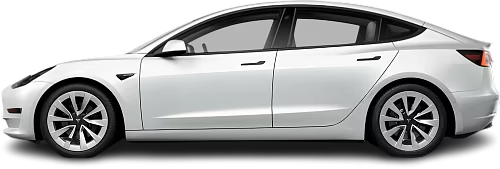Global EV Comparison: Chevrolet Spark EV 21 kWh vs Tesla Model 3 Mid Range
Struggling to Decide? Let AI Help!
Your AI Summary Is Ready!
General Info
Both vehicles have been discontinued and were never available for sale in Europe.
The Chevrolet Spark EV 21 kWh (2013-2014) is a Hatchback, whereas the Tesla Model 3 Mid Range (2018-2020) is a Sedan.
| Property | Chevrolet Spark EV 21 kWh | Tesla Model 3 Mid Range |
|---|---|---|
| Years of Production | 2013-2014 | 2018-2020 |
| Current Status | Discontinued | Discontinued |
| Country of Manufacture | South Korea | USA |
| Body Style | Hatchback | Sedan |
| Market Availability | USA | USA |
| GCC Score | 4.1 | 6 |
Range and Efficiency
The Tesla Model 3 Mid Range (2018-2020) boasts a greater real-world range, a larger battery, and superior energy efficiency compared to the Chevrolet Spark EV 21 kWh (2013-2014).
| Property | Chevrolet Spark EV 21 kWh | Tesla Model 3 Mid Range |
|---|---|---|
| Range (EPA) | 132 km | 425 km |
| Range (WLTP) | - Range (WLTP) | 457 km |
| Range (GCC) | 125 km | 396 km |
| Battery Capacity (Nominal) | 21.4 kWh | 65 kWh |
| Battery Capacity (Usable) | 20 kWh | 62 kWh |
| Efficiency per 100 km | 16 kWh/100 km | 15.7 kWh/100 km |
| Efficiency per kWh | 6.25 km/kWh | 6.39 km/kWh |
| Range and Efficiency Score | 5.2 | 7.6 |
Charging
Both vehicles utilize a standard 400-volt architecture.
The Tesla Model 3 Mid Range (2018-2020) offers faster charging speeds at DC stations, reaching up to 200 kW, while the Chevrolet Spark EV 21 kWh (2013-2014) maxes out at 50 kW.
The Tesla Model 3 Mid Range (2018-2020) features a more powerful on-board charger, supporting a maximum AC charging power of 7.7 kW, whereas the Chevrolet Spark EV 21 kWh (2013-2014) is limited to 3.3 kW.
| Property | Chevrolet Spark EV 21 kWh | Tesla Model 3 Mid Range |
|---|---|---|
| Max Charging Power (AC) | 3.3 kW | 7.7 kW |
| Max Charging Power (DC) | 50 kW | 200 kW |
| Architecture | 400 V | 400 V |
| Charge Port | CCS Type 1 | Tesla (NACS) |
| Charging Score | 2.6 | 5.6 |
Performance
The Tesla Model 3 Mid Range (2018-2020) is rear-wheel drive, while the Chevrolet Spark EV 21 kWh (2013-2014) offers a front-wheel drive system.
The Tesla Model 3 Mid Range (2018-2020) boasts greater motor power and accelerates faster from 0 to 100 km/h.
| Property | Chevrolet Spark EV 21 kWh | Tesla Model 3 Mid Range |
|---|---|---|
| Drive Type | FWD | RWD |
| Motor Type | PMSM | PMSM |
| Motor Power (kW) | 105 kW | 202 kW |
| Motor Power (hp) | 140 hp | 271 hp |
| Motor Torque | 542 Nm | 404 Nm |
| 0-100 km/h | 7.8 s | 5.5 s |
| Top Speed | 145 km/h | 225 km/h |
| Performance Score | 3.5 | 5 |
Dimensions
The Tesla Model 3 Mid Range (2018-2020) is longer and wider, but the Chevrolet Spark EV 21 kWh (2013-2014) is taller.
The Tesla Model 3 Mid Range (2018-2020) boasts a more extended wheelbase.
| Property | Chevrolet Spark EV 21 kWh | Tesla Model 3 Mid Range |
|---|---|---|
| Length | 3721 mm | 4695 mm |
| Width (with Mirrors) | - Width (with Mirrors) | 2088 mm |
| Width (w/o Mirrors) | 1626 mm | 1850 mm |
| Height | 1590 mm | 1445 mm |
| Wheelbase | 2375 mm | 2875 mm |
Cargo and Towing
The Tesla Model 3 Mid Range (2018-2020) provides more cargo capacity, featuring both a larger trunk and more space with the rear seats folded.
A frunk (front trunk) is available in the Tesla Model 3 Mid Range (2018-2020), but the Chevrolet Spark EV 21 kWh (2013-2014) doesn’t have one.
The Tesla Model 3 Mid Range (2018-2020) has a towing capacity of up to 910 kg, whereas the Chevrolet Spark EV 21 kWh (2013-2014) is not officially rated for towing in the EU.
| Property | Chevrolet Spark EV 21 kWh | Tesla Model 3 Mid Range |
|---|---|---|
| Number of Seats | 4 | 5 |
| Curb Weight | 1356 kg | 1672 kg |
| Cargo Volume (Trunk) | 273 l | 561 l |
| Cargo Volume (Max) | 663 l | 1235 l |
| Cargo Volume (Frunk) | - Cargo Volume (Frunk) | 88 l |
| Towing Capacity | - Towing Capacity | 910 kg |
| Cargo and Towing Score | 4.2 | 5.1 |




